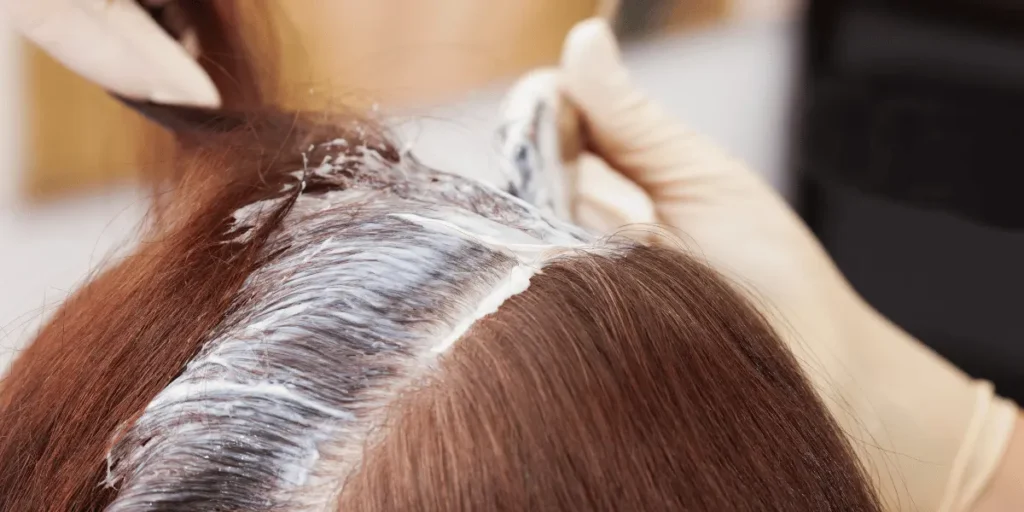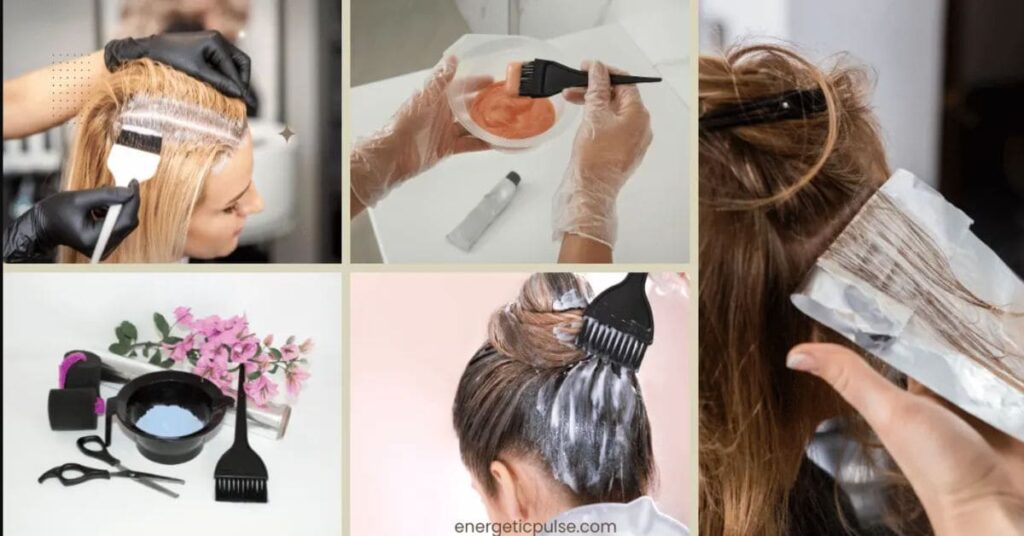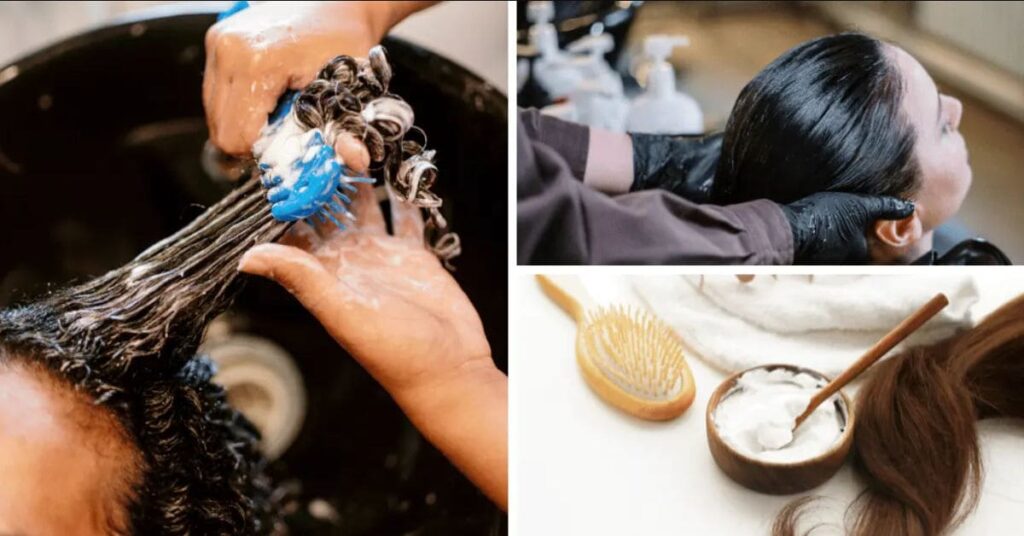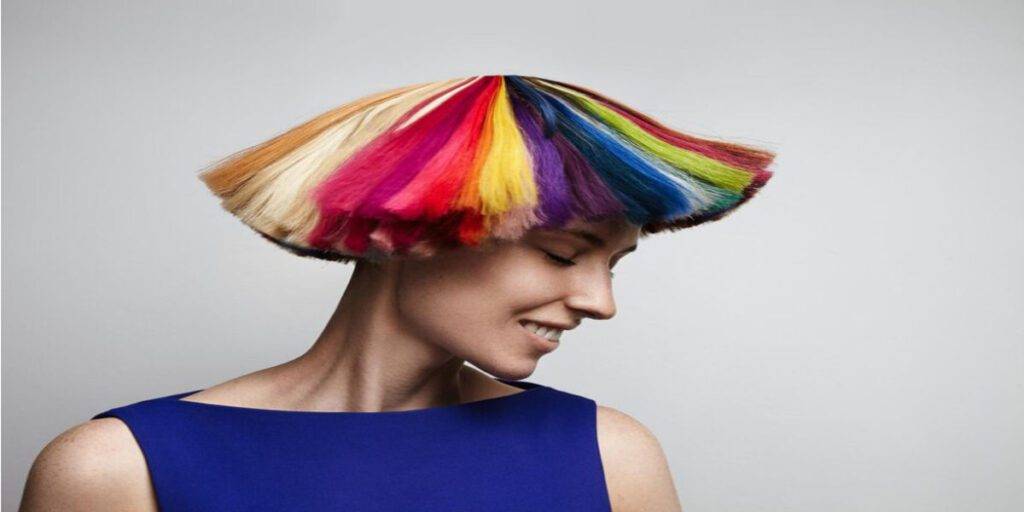Welcome to the vibrant world of hair dyeing, where self-expression meets style! In our quest for individuality, the myriad techniques of hair coloring offer a canvas for endless creativity. From temporary transformations to permanent makeovers, this article explores the diverse realm of “Types of Hair Dyeing Techniques.” Whether you’re a color connoisseur or a newcomer to the world of hair dye, this concise guide will walk you through the various methods, trends, and essential tips to help you make informed choices. Dive in, discover your perfect hue, and let your hair tell its unique story!
1. Temporary Hair Dyeing Methods
Hair enthusiasts often seek a change that’s not committed for the long haul. Temporary hair dyeing methods provide the perfect solution, allowing experimentation without a permanent commitment.
Washable Dyes:
- Overview: Washable dyes are a playful way to experiment with different colors for a short period.
- Application: Easily applied at home without professional assistance, these dyes typically last for a few washes.
- Ideal for: individuals looking for a quick and non-committal change in appearance.
Semi-Permanent Dyes:
- Introduction: Offering a middle ground between washable and permanent options, semi-permanent dyes provide a longer-lasting color without permanency.
- Duration: Lasting for several weeks, these dyes gradually fade, allowing for a gentle transition back to the natural hair color.
- Variety: Available in a wide range of shades, allowing users to experiment with different tones and intensities.
Benefits and Limitations:
- Advantages: Temporary dyes are an excellent choice for those who enjoy frequent changes, allowing them to switch colors without commitment.
- Limitations: However, the temporary nature means more frequent reapplication is necessary for those wanting a sustained, vibrant look.
In the realm of temporary hair dyeing, washable and semi-permanent options provide a low-risk playground for personal style exploration. Whether you’re looking for a weekend transformation or want to test a new color before making a permanent decision, these methods offer a world of possibilities without long-term consequences. So, if you’re ready for a temporary change that packs a punch, let’s delve deeper into the world of hair color experimentation!
2. Permanent Hair Dyeing Techniques
For those seeking a more enduring transformation, permanent hair dyeing techniques offer a lasting change to one’s appearance. Let’s delve into the traditional methods that have stood the test of time.
Traditional Permanent Dyes:
- Process Overview: Traditional permanent dyes use a combination of ammonia and peroxide to lift the natural hair color and deposit the new color.
- Color Longevity: These dyes offer long-lasting results, with color persisting until new hair growth occurs.
- Professional vs. At-Home Application: While professional salons commonly use these dyes, at-home kits are also widely available for those comfortable with the application process.
Variety and Customization:
- Wide Range of Colors: Permanent dyes provide an extensive palette, allowing individuals to choose from a spectrum of colors to suit their preferences.
- Customization: Colorists can mix shades to achieve a customized look, adding a personalized touch to the coloring process.
Root Touch-Ups:

- Maintenance: One of the benefits of permanent dyes is the ease of addressing root regrowth.
- Frequency: Depending on the rate of hair growth, periodic touch-ups are required to maintain a seamless color appearance.
Considerations and precautions:
- Hair Health: The permanency of these dyes requires careful consideration of hair health, as the process involves chemicals that may affect the hair structure.
- Patch Tests: Conducting patch tests before application is essential to identify potential allergic reactions.
Permanent hair dyeing techniques offer a transformative experience that withstands the test of time. While the process requires a more committed approach, the variety, customization options, and long-lasting results make it a popular choice for those seeking a profound change. Whether you’re considering a salon visit or planning an at-home application, understanding the nuances of permanent dyes ensures a successful and satisfying coloring experience. Now, let’s explore the world of highlights and lowlights, adding dimension and intrigue to your colored locks!
3. Highlights and Lowlights
In the realm of hair coloring, the artistry of highlights and lowlights adds depth and dimension to a base color, creating a dynamic and visually appealing look.
Overview of Highlights and Lowlights:
- Purpose: Highlights involve lightening strands of hair, while lowlights add darker tones. The combination enhances the overall texture and movement of the hair.
- Natural Appearance: Mimicking the way the sun naturally lightens and darkens hair, highlights and lowlights create a sun-kissed, authentic appearance.
Techniques for Application:
- Foiling: A common method involves wrapping selected strands in foil before applying color, allowing for precise placement and controlled development.
- Balayage and Ombre: Freehand painting techniques, like balayage, create a seamless transition between colored and natural strands. Ombre involves a gradual fade from dark to light.
Benefits of Highlights and Lowlights:
- Dimension: Adding lighter and darker tones creates an illusion of depth, making the hair look fuller and more voluminous.
- Face Framing: Strategically placed highlights around the face draw attention to facial features, enhancing the overall effect.
Maintenance and Growing Out:
- Low Maintenance: Compared to full-coverage colors, highlights and lowlights generally require less maintenance as regrowth is less noticeable.
- Natural Transition: As the color grows out, the transition is often more subtle and natural-looking, reducing the need for frequent touch-ups.
Choosing Colors:
- Complementary Shades: Selecting colors that complement the base shade creates a harmonious and visually pleasing result.
- Bold Choices: For those seeking a bolder look, contrasting colors can be chosen for a more dramatic effect.
DIY vs. Professional Application:
- DIY Kits: While at-home kits are available, achieving professional-looking results may require skill and practice.
- Professional Expertise: Skilled colorists can customize the placement and intensity of highlights and lowlights for a personalized outcome.
Incorporating highlights and lowlights into your hair color journey is a versatile and effective way to elevate your style. Whether you prefer a subtle, natural enhancement or a bold, dramatic transformation, the world of highlights and lowlights awaits, promising a journey of creativity and self-expression. Now, let’s explore the artistic techniques of balayage and ombre, adding a touch of freehand elegance to your colored locks!
Balayage and Ombre Effects
Balayage and ombre techniques have revolutionized the world of hair coloring, offering a seamless and natural-looking transition between different shades. Let’s dive into the artistry behind these freehand painting methods.
Balayage:
- Definition: Balayage, meaning “to sweep” in French, involves hand-painting highlights onto sections of the hair.
- Technique: The colorist applies color in a sweeping motion, creating a soft, graduated effect with a natural blend between the colored and natural strands.
- Result: The result is a sun-kissed, lived-in look, with lighter strands concentrated towards the ends.
Ombre:
- Definition: Ombre, derived from the French word meaning “shadow,” is characterized by a gradual transition from dark to light.
- Technique: The colorist blends the colors horizontally, creating a noticeable contrast between the roots and ends.
- Result: Ombre provides a bold and striking effect, often with darker roots and progressively lighter tips.
Choosing Between Balayage and Ombre:
- Natural vs. Bold: Balayage offers a more natural, subtle transition, while ombre provides a bolder, more defined contrast.
- Maintenance: Balayage generally requires less maintenance as it grows out more naturally, whereas ombre may need more frequent touch-ups.
Hair Length and Texture Considerations:
- Suitability: Both techniques are adaptable to various hair lengths and textures, making them versatile choices for many individuals.
- Face Framing: Balayage and ombre can be strategically placed to frame the face, accentuating features.
DIY vs. Professional Application:
- Complexity: Achieving the desired effect with balayage and ombre may be challenging for beginners, as precision is crucial.
- Professional Expertise: Skilled colorists can tailor the technique to suit individual preferences, ensuring a customized and expertly executed result.
Balayage and ombre techniques add an effortless and artistic touch to your hair, allowing for a low-maintenance yet high-impact transformation. Whether you’re drawn to the subtlety of balayage or the boldness of ombre, these techniques promise a stunning visual appeal that celebrates individuality. Now, let’s unravel the precision of foil highlighting methods, offering a different approach to achieving a beautifully detailed and controlled color outcome!
4. Foil Highlighting Methods
Foil highlighting is a precise and controlled technique that has become a staple in the world of hair coloring. This method utilizes foils to separate strands, ensuring targeted color application and stunning, defined results.
Process of Foil Highlighting:
- Sectioning: Hair is sectioned and divided into thin strands.
- Application: Color is applied to each strand, and the hair is then wrapped in aluminum foil, creating a barrier that enhances color development.
- Precision: Foil highlighting allows for precise placement of color, resulting in a well-defined and intricate outcome.
Benefits of Foil Highlighting:
- Controlled Placement: The use of foils provides colorists with greater control over where the highlights are placed, allowing for strategic and detailed designs.
- Intensity and Contrast: Foil highlighting can achieve a high level of color intensity and contrast, making it ideal for those seeking a vibrant and dynamic look.
Variations in Foil Highlighting:
- Full Foil: Encompassing the entire head, full foil highlighting offers a comprehensive transformation with a uniform color distribution.
- Partial Foil: Focusing on specific sections, partial foil highlighting allows for customization and targeted color application.
Blending Techniques:
- Weaving: Colorists may weave selected strands through the foils, creating a more natural and blended effect.
- Slicing: Alternatively, slicing involves taking wider sections, resulting in bolder and more noticeable highlights.
Maintenance and Growing Out:
- Root Regrowth: Like other highlighting methods, foil highlights require periodic touch-ups to address visible root regrowth.
- Gradual Transition: The foil technique often facilitates a smoother and more gradual transition as the color grows out.
DIY vs. Professional Application:
- Complexity: While foil highlighting can be done at home with the right tools and products, achieving professional-level results may require practice.
- Professional Expertise: Skilled colorists bring an artistic touch to foil highlighting, tailoring the placement and intensity to suit individual preferences.
Foil highlighting methods offer a meticulous and controlled approach to achieving stunning highlights. Whether you opt for a full transformation or prefer a subtler touch, the use of foils ensures a tailored and detailed outcome. Now, let’s explore the kaleidoscopic world of creative hair dyeing trends, where unconventional and avant-garde colors take center stage in the realm of personal expression!
5. Creative Hair Dyeing Trends
Dive into the world of artistic expression with creative hair dyeing trends that go beyond the traditional color spectrum. From vibrant rainbows to pastel dreams, these unconventional techniques redefine the boundaries of hair coloring.
Rainbow Colors:
- Overview: Embrace the entire color spectrum with rainbow hair, featuring a kaleidoscope of vibrant hues.
- Application: Colorists strategically apply different shades to create a harmonious and eye-catching rainbow effect.
- Personalization: Customize the rainbow palette to reflect personal preferences or embrace seasonal themes.
Pastel Tones:
- Soft and Subtle: Pastel colors, such as lavender, mint, or blush pink, offer a softer and more understated alternative to bold and bright hues.
- Versatility: Pastels can be applied as an overall color or incorporated into specific sections for a more intricate look.
Neon and Fluorescent Shades:
- Bold and Daring: Neon and fluorescent colors make a bold statement, drawing attention with their high visibility and intensity.
- UV Reactive Options: Some formulations even glow under UV light, adding an extra layer of excitement for special occasions.
Metallic Hues:
- Shimmering Effects: Metallic dyes, including silver, gold, and copper, create a lustrous and reflective finish.
- Trendy Accents: Metallic shades can be applied as highlights or blended into the overall color for a trendy and modern aesthetic.
Color Blocking:
- Defined Sections: Color blocking involves applying distinct blocks of color to different sections of the hair.
- Geometric Patterns: This technique allows for the creation of geometric patterns or a more structured and bold appearance.
Temporary Hair Tattoos and Stencils:
- Artistic Detailing: Temporary hair tattoos or stencils offer a way to add intricate patterns or designs to colored hair.
- Flexibility: Easily changeable, these temporary additions allow for dynamic and evolving styles.
Maintenance and Care:
- Color-Friendly Products: Using products specifically designed for colored hair helps maintain vibrancy and prolong the life of unconventional colors.
- Regular Touch-Ups: Depending on the chosen trend, regular touch-ups may be required to keep the colors looking fresh and vibrant.
Expression and Individuality:
- Beyond Conformity: Creative hair dyeing trends provide an avenue for self-expression, allowing individuals to break free from conventional norms and embrace their unique style.
- Temporary vs. Permanent Options: Choose trends that align with personal preferences, whether seeking a long-term commitment or a temporary burst of creativity.
Creative hair dyeing trends offer a playground for self-expression, pushing the boundaries of traditional hair coloring. Whether you’re drawn to the boldness of neon shades, the softness of pastels, or the shimmer of metallic hues, these trends allow you to become a canvas for your own artistic vision. Now, let’s explore the roots of natural hair dyeing alternatives, delving into the world of henna, indigo, and other plant-based color options!
6. Natural Hair Dyeing Alternatives
Explore the organic side of hair coloring with natural alternatives that not only infuse color but also nourish and care for your locks. From the age-old tradition of henna to lesser-known plant-based options, natural hair dyeing opens up a world of botanical beauty.
Henna:
- Traditional Dye: Derived from the leaves of the henna plant, Lawsonia inermis, henna has been used for centuries for its natural coloring properties.
- Reddish Tones: Henna predominantly imparts reddish tones to the hair, and its effects deepen with successive applications.
- Conditioning Properties: Known for its conditioning benefits, henna also adds shine and strength to the hair.
Indigo:
- Blue-Black Hues: Indigo, extracted from the plant Indigofera tinctoria, is often used in conjunction with henna to achieve deep blue-black shades.
- Natural Dyeing Process: Indigo requires a two-step process where henna is applied first, followed by indigo for a rich, dark color outcome.
Cassia Obovata (Neutral Henna):
- Conditioning and Shine: Cassia obovata, often referred to as neutral henna, imparts a pale yellow tint to the hair.
- Conditioning Properties: Like henna, cassia obovata conditions and adds shine to the hair without significantly altering its natural color.
Black Walnut Powder:
- Natural Darkening: Ground from the hulls of black walnuts, this powder offers a natural method for darkening hair.
- Brown to Black Shades: When used consistently, black walnut powder can darken brown hair and, in some cases, achieve black hues.
Chamomile:
- Lightening Effects: Chamomile, known for its soothing properties, also has natural lightening effects on the hair.
- Golden Highlights: Regular use of chamomile can result in subtle golden highlights, especially on lighter hair tones.
Beet Juice and Carrot Juice:
- Vegetable Dyes: Beet juice and carrot juice are natural vegetable-based dyes.
- Temporary Effects: While these juices may not provide long-lasting color, they can impart temporary vibrant shades, especially in lighter hair.
Coffee and Tea Rinse:
- Darkening Effects: Coffee and black tea rinses offer natural ways to darken the hair.
- Temporary Stain: These natural alternatives provide a temporary stain that gradually fades over time.
Application Tips:
- Mixing and Consistency: Achieving the desired color requires proper mixing and consistency, often involving the combination of natural ingredients and liquids like water or herbal teas.
- Patch Tests: Conduct patch tests before full application to ensure compatibility and avoid adverse reactions.
Natural hair dyeing alternatives provide an eco-friendly and chemical-free approach to coloring, celebrating the beauty of nature’s pigments. Whether you’re drawn to the earthy richness of henna or experimenting with the golden hues of chamomile, these options offer a gentle yet effective way to enhance your hair’s natural beauty. Now, let’s delve into the essential aspects of maintenance and aftercare, ensuring your colored locks stay vibrant and healthy!
7. Maintenance and Aftercare Tips
Maintaining the vibrancy and health of colored hair requires a thoughtful approach to care and maintenance. Whether you’ve opted for temporary, permanent, or natural coloring methods, adopting the right aftercare routine ensures your colored locks stay stunning and vibrant.
Use Color-Safe Products:
- Sulfate-Free Shampoos: Choose sulfate-free shampoos to avoid stripping the hair of color.
- Color-Enhancing Conditioners: Use conditioners formulated for colored hair to maintain moisture and vibrancy.
Cold water rinses:
- Seal Cuticles: Rinse hair with cold water to help seal the cuticles and prevent color from fading.
- Reduce Color Bleeding: Cold water also helps reduce color bleeding, especially in the initial days after coloring.
Limit Washing Frequency:
- Extend Color Longevity: Reduce the frequency of hair washing to prevent premature color fading.
- Dry Shampoo: Incorporate dry shampoo between washes to keep hair fresh without overwashing.
Protect from UV rays:
- Sunscreen for Hair: Just as skin needs protection from UV rays, hair does too. Use hair products with UV protection to shield against sun damage.
- Hats and Scarves: Wear hats or scarves when exposed to prolonged sunlight to minimize color fading.
Deep Conditioning Treatments:
- Hydration and Nourishment: Periodic deep conditioning treatments provide essential hydration and nourishment, particularly for chemically treated hair.
- Avoid Overuse: Balance deep conditioning to prevent product buildup and maintain volume.
Avoid hot styling tools:
- Heat Protection Products: If hot styling tools are necessary, use heat protection products to minimize damage.
- Cooler Settings: Opt for cooler settings on styling tools to avoid excessive heat exposure.
Regular Trims:
- Prevent Split Ends: Regular trims prevent split ends, promoting overall hair health and preserving the appearance of colored locks.
- Maintain Shape: Trimming helps maintain the shape of the hairstyle, ensuring a polished look.
Consider water quality:
- Hard Water Effects: Hard water can affect the vibrancy of hair color. Consider using a water softener or special treatments if hard water is an issue.
- Filtered Water Rinses: Rinsing hair with filtered water can help mitigate the impact of hard water.
Avoid chlorine exposure:
- Swimming Precautions: Take precautions when swimming in chlorinated pools. Wear a swimming cap or wet your hair with clean water before entering the pool to reduce chlorine absorption.
Color touch-ups and refreshing:
- Scheduled Touch-Ups: Plan regular touch-ups to maintain the color’s freshness.
- Temporary Color Refreshers: For temporary color, consider using color-refreshing products between touch-ups to extend the vibrancy.
Maintaining and caring for colored hair is essential to preserving its vibrancy and health. Whether you’ve chosen a bold creative trend or embraced the subtlety of natural alternatives, a consistent and tailored aftercare routine ensures that your colored locks remain a radiant reflection of your style. Now, let’s guide you through the process of choosing the right technique for you, considering factors such as lifestyle, maintenance, and desired outcomes.
8. Choosing the Right Technique for You
Selecting the ideal hair dyeing technique involves thoughtful consideration of various factors, ensuring that your choice aligns with your lifestyle, maintenance preferences, and desired overall look. Here’s a guide to help you navigate the decision-making process:.
Lifestyle Considerations:
- Time Commitment: Assess the time you are willing to invest in the initial coloring process and subsequent maintenance.
- Frequency of Change: Consider whether you prefer a more permanent change or the flexibility to switch colors frequently.
Maintenance Preferences:
- Touch-Up Frequency: Evaluate how often you’re willing to schedule touch-ups to maintain the color’s freshness.
- At-Home vs. Salon Maintenance: Determine if you prefer at-home maintenance or regular salon visits for professional touch-ups.
Desired Outcome:
- Natural vs. Bold: Clarify if you lean towards a more natural look or if you’re open to bold and unconventional color choices.
- Dimension and Depth: Decide whether you want to add dimension and depth to your hair through techniques like highlights and lowlights.
Hair Health Considerations:
- Chemical Sensitivity: Assess your sensitivity to chemicals and choose methods that align with your comfort level.
- Hair Damage: Consider the impact of certain dyeing techniques on hair health, especially if your hair is already damaged or prone to dryness.
Personal Style and Expression:
- Individuality: Embrace your individual style and choose a technique that reflects your personality and self-expression.
- Trend Exploration: If you enjoy staying on-trend, consider creative hair dyeing trends that offer a dynamic and fashionable appearance.
Budget Considerations:
- Salon vs. At-Home Costs: Compare the costs associated with salon visits versus at-home coloring kits.
- Frequency of Expense: Assess the long-term financial commitment based on the chosen dyeing technique.
Experimentation Tolerance:
- Readiness for Change: Evaluate your comfort level with experimenting and making changes to your hair color.
- Temporary vs. Permanent Choices: Consider whether you prefer the flexibility of temporary colors or the longevity of permanent ones.
Professional Consultation:
- Expert Advice: If uncertain, consult with a professional colorist for personalized advice based on your hair type, preferences, and lifestyle.
- Color Matching: Professionals can also assist in color matching to ensure the chosen hue complements your skin tone.
Trial Periods:
- Start with temporary: If uncertain, begin with temporary colors or highlights to test the waters before committing to a more permanent change.
- Gradual Exploration: Gradually experiment with different techniques to discover what resonates best with your style.
Choosing the right hair dyeing technique is a personal journey that involves a blend of practical considerations and self-expression. By carefully weighing factors such as maintenance, lifestyle, and desired outcomes, you can make an informed decision that aligns with your unique preferences. Whether you opt for the timeless appeal of permanent dyes, the creative expression of trends, or the natural beauty of plant-based alternatives, your hair can become a canvas for your individual style. Enjoy the exciting journey of transforming and expressing yourself through the world of hair coloring!
Conclusion
In the vibrant tapestry of “Types of Hair Dyeing Techniques,” we’ve explored a spectrum of possibilities, each offering a unique avenue for self-expression and style. Whether you’re drawn to the precision of foil highlighting, the artistic freedom of balayage, or the earthy richness of natural alternatives, the world of hair coloring caters to diverse tastes and preferences. As you embark on your personal hair color journey, consider the factors that resonate with your lifestyle, desired outcomes, and individuality. With proper aftercare and maintenance, your colored locks can radiate vibrancy and health, reflecting the beauty of your chosen technique. Embrace the dynamic realm of hair dyeing, where each strand becomes a canvas for your unique story, allowing you to boldly express your style and creativity


